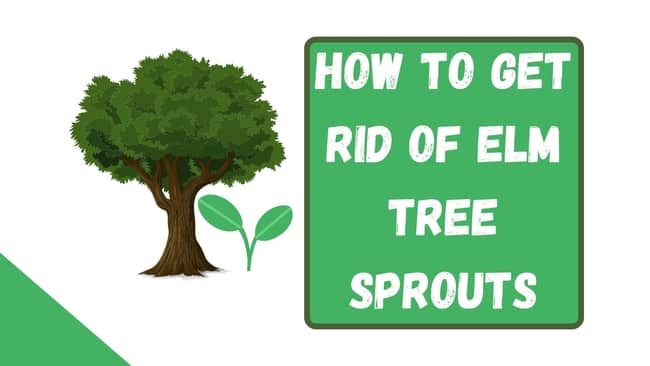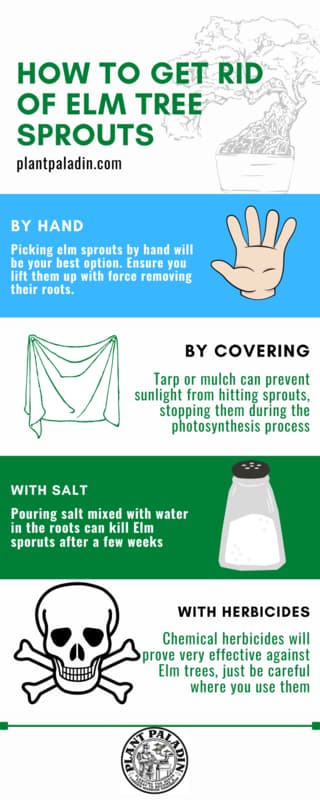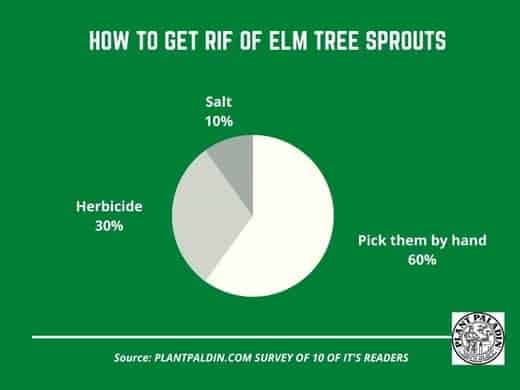This website is supported by its readers. If you click one of my links I may earn a commission. I am also a participant in the Amazon affiliates program and I will also earn a commission from qualified purchases.

So recently, I had to kill an invasive Chinese Elm tree growing at the bottom of my garden. While this removed most of the problem I was facing, I’ve noticed a few new Chinese Elm sprouts growing both on the old stump and in and around the stump. As such, this got me asking how to get rid of Elm tree sprouts.
To get rid of Elm tree sprouts, pick them by hand or use a pricking-out tool. Ensure this is undertaken when the sprouts are young so the roots are removed easily.
So what methods are the best methods to use when figuring out how to get rid of Elm tree sprouts? And when is the perfect time to remove Elm tree sprouts? Keep reading to find out more!
Just a quick heads up, over the past three years of running Plantpaladin, hundreds of people have asked for product recommendations. As such, You can find my favorite indoor bonsai tree here (link takes you to Bonsaiboy), my favorite outdoor bonsai tree (link takes you to Bonsaiboy), or have a look at all the products I recommend here.
How to get rid of Elm tree sprouts
Elm trees and Chinese Elm trees make for fantastic trees.
They are super durable, can be grown indoors and outdoors, and make for fantastic bonsai!
That being said, these trees can be very invasive.
One such problem that many other people and I have regarding Elm trees is the tree sprouts that grow from seedlings.
As Elm trees are incredibly versatile then, these sprouts can grow in almost any condition, taking valuable nutrients away from other plants and trees in your collection.
I got in touch with my local botanical gardens, asked a few Plant Paladin readers, and even asked a few experts on Chinese Elm how to solve this problem – All to ensure you had the most comprehensive post on how to get rid of Elm tree sprouts.
To summarise:
- The best method to get rid of Elm tree sprouts is to pick them up, either by hand, with a pencil, or a specialty seedling picker tool when the seedling is young.
- Doing so will allow you to uproot the roots of the seedlings ensuring they do not grow back.
- Picking up sprouts by hand works best when the seedling is four weeks old or less.
- If the seedlings are older, chemical pesticides will need to be used.
- The best pesticides to use will contain chemicals such as Triclophyr and Glyphosate.
- Cutting off the light supply or reducing water intake can also prevent them from growing.
Let’s go into more detail about the different methods you can use to kill Elm seedlings:

Pick by hand
So the first method and method that is easiest to follow with the best results is to remove the Elm tree seedling by hand.
Removing by hand can be done in four ways:
- Picking by hand
- Pencils
- Bespoke seedling picking tool
- Using a shovel
Using the hand method works best when your seedling is younger, so a month or less.
The larger a seedling is, the more it will require some of the other methods on this list.
To go into more detail on the above four methods:
Picking by hand
Picking by hand is the easiest method to use. Just make sure you wear gloves!
To use, grasp the central stem of the Elm seedling (this will eventually turn into the trunk of your seedling) between your index finger and your thumb.
Then gently push upwards to remove the seedling.
If you have done this at the right time, the roots should come out with the seedling.
For best results, consider removing the surrounding soil from which the seeling is growing to make it easier.
Alternatively, if the seedling is growing directly from the stump of an old Elm tree, remove the stump in its entirety.
Using a pencil
An alternative method of removing the Elm tree sprout would be to use a tool like a pencil to pry it loose.
Pencils work well when your seedlings are grouped up against a wall or fence and are harder to pull out.
Again this works best for seedlings that are a month old or less.
Hold a leaf near the top of the seedling, between your thumb and index finger.
Then using the pencil, dig the soil underneath the seedling to loosen up the roots.
Then lift the seedling out.
If the seedling is a little taller and more rigid, consider wrapping the seedling stem around the pencil and then pull it out.
Doing so will give you more leverage for those more demanding Elm tree seedlings.
Using a bespoke seedling picking tool
Similar to the point above, if you don’t have a pencil or don’t want to use your hand, there are bespoke seed picking tools that will do the job for you.
They typically come with attachments to hold the seedling or dig up the soil.
However, using them will be the same as if you were using a pencil.
All these tools will grant you extra leverage when removing the seedlings.
Use a shovel
Finally, if you have a large cluster of seedlings grouped and you want to do this in as short a space of time as possible, consider using either a trowel or shovel to gid up the seedlings.
If undertaken when the seedlings are one month old or less, these should be easily removed via a shovel.
Cover with mulch
So if you have tried removing the sprouts by hand but found that to be unsuccessful, another fantastic organic method to remove the seedlings would be to cover the seedlings with mulch.
I find that this works well if your Elms sprouts are growing on a lawn or grouped in a bunch.
Covering with mulch will block out the sunlight from the sprouts’ view.
Without sunlight, the Elm seeds won’t be able to photosynthesize the light.
Mulching will cause their leaves to dry up, turn yellow and eventually fall off and die.
Any organic mulch can be used for this, but using dead leaves, sand, and other grit usually works the best.
If you are removing Elm tree sprouts from a pot or an Elm tree you keep indoors, you can still use mulch; ensure you cover the potting soil until all the sprouts are covered.
Just be careful that the mulch had not got any mold which can cause sap to leak from the tree.
Cover with tarp
While removing the sunlight is one way of killing Elm tree sprouts, another route to go down would be to limit the amount of water Elm trees need.
Elm trees require a lot of watering when they are young, so cutting this off will prevent the tree from growing its roots and stop the growth of Elm sprouts.
Use a waterproof tarp that will not allow water to seep through.
Then use pegs to cover the ground in a one-meter diameter around the seedlings.
The one-meter radius will prevent the roots from accessing rainwater directly around the tree.
Covering with a plastic tarp will also block out the sunlight having the added benefit of the step above.
Cover with salt
Salting the earth is a method that has been around for literally thousands of years.
Roman legions used to do so as a wartime tactic to kill any plant life.
As such, salt can be very effective at killing Elm sprouts.
Then, mix a solution of 50% salt with 100% water and then pour directly over the seedlings.
The salt should pour down to the roots of the sprouts, killing them and stopping them from growing back again.
Consider drilling in a few holes around the Elm sprouts to make this method more effective, especially if you have a group of sprouts together.
Drilling will give direct access to the roots for the salt and water solution making it easier to kill.
Just ensure you are careful where you pour the solution of salt and water, which can potentially cause harm to surrounding vegetation.
Now salt can be more complicated if the Elm tree sprouts are suckers that have formed on or near an Elm tree – especially if you want to keep the existing Elm tree.
If this is the case, consider removing it by hand for best results.
Use herbicides
While the above natural methods work very well at removing Elm tree sprouts, if your sprouts are older or you have tried the above methods to no avail, chemical herbicides will need to be used.
Most generic garden center herbicides will work well; however, the chemicals in herbicides that work particularly well include:
- Glyphosate
- Triclopyr
That being said, be careful when using Glyphosate.
Glyphosate will kill pretty much everything in its path because it is a non-selective herbicide.
If you have other flora located in and around your sprouts, you will want to be careful using this.
On the other hand, Triclopyr is more selective, specifically targeting broadleaf trees such as Elm trees.
As such, herbicides containing this chemical will be beneficial if you have seedlings located on or around a lawn.
Hire a professional
Finally, if you have tried the above methods and are still struggling to remove the Elm sprouts, consider hiring a professional.
Professionals have access to chemicals and methods not commonly available for me and you to purchase and have decades’ worth of experience in removing sprouts and pests of every denomination.
If you have a stubborn Elm sprout that won’t budge, bring in the professionals.
Why it’s essential to get rid of Elm sprouts
It is vital to remove Chinese Elm sprouts as the sprouts are invasive. Elm sprouts can take away the nutrients and minerals from the soil that surrounding plants will need.
If left unchecked, this can kill the trees or plants you have growing in your back garden.
Elm sprouts also need to be removed as if left to grow, and the roots will grow large, unearthing surrounding materials such as pathways, fences, and weak structures.
Finally, some Elm tree sprouts grow in the soil of existing Elm trees as offshoots.
Failing to remove these can weaken a larger, healthier Elm tree as Elm sprouts vie for nutrients in the soil.
When to get rid of Elm sprouts
The best time to remove Elm tree sprouts will be when they are young, ideally when the sprouts are a month older or younger. This will make removing them by hand much more straightforward and prevent you from needing to use chemical herbicides.
Where do Elm tree sprouts grow
Elm tree sprouts typically grow either when the seeds fall from an Elm tree into an open space or as an offshoot from the main tree. Elm tree sprouts also grow on top of stumps of dead Elm trees.
Are organic methods or inorganic methods better?
So in the post, we have covered both organic and inorganic methods of removing Elm sprouts.
Both have pros and cons.
Organic methods typically are a lot less harsh to surprising plants and trees.
Organic methods work well if you have something like a bonsai collection and are worried about killing off a more extensive selection of your trees.
Alternatively, if you only have a singular Elm sprout that you are struggling with in an open space, then opting to use a more harsh chemical solution will typically work better.
Organic methods will typically take longer to achieve the desired result. For example, using salt will sometimes need to be undertaken several times to remove the sprout.
Alternatively, chemical compounds can often shorten the time it takes to kill the sprout.
Aftercare once Elm sprouts have been removed.
So once you have utilized the methods above, a common mistake I made was leaving the sprouts in the ground.
My thought was that once the chemicals have done their job, the sprouts will have withered and fallen away.
Do not make this same mistake.
Instead, once your Elm sprouts have died, dig them up to the root and throw them away.
While these roots can sometimes seem dead, you will be surprised how much damage they can take, so ensure you remove the roots from your garden once the sprouts have disappeared.
How to get rid of Elm sprouts growing on top of the stump?
So as mentioned, it is common for Elm sprouts to grow on top of dead Elm stumps as the roots search for ways to revive the tree.
It’s super common then to see sprouts growing on Elm stumps on what you assumed was dead.
Luckily this too can be treated both organically and inorganically.
To treat naturally, drill several holes in the stump and an angle and pour in a solution of 50% salt to 100% water.
The salt will hopefully kill the roots in their entirety.
Once the roots are dead, dig up the stump and move it to your local waste disposal center.
A chemical alternative that works well is to use stump killer on the stump. Stump killer works in much the same way as salt, whereby the chemicals will contact the stump’s roots and kill the stump.
Elm stump still contains many dense nutrients, so if you have sprouts growing on the stump, this is most commonly the reason.
Survey on how to get rid of Elm tree sprouts
So finally, I undertook a quick survey of 10 plant paladin readers who have successfully managed to remove Elm tree sprouts. Seedlings.
I asked them what method they used to do this.
To summerise:

Finally, a lot of you reading this will also be growing Elm trees as a hobby, such as bonsai. If this is the case with yourself, feel free to check out a quick care guide in the table below:
Chinese Elm Bonsai tree Requirements | Explained |
Water | Once per day in the spring-summer or if kept indoors. Once per week if kept outdoors during the winter. Only water if dry to touch. |
Sunlight | 6 hours of direct sunlight in the summer. LED grow light can also be used. |
Temperature | Between 60 degrees F and 100 degrees F |
Fertilizer | Once per month during the spring and summer. No fertilization is required in the fall or winter. |
Repotting | Once every 2 to 3 years in the first 10 years. You can then report once every 5 years |
Placement | Can be placed outdoors in direct sunlight or indoors in a bright spot. |
Wire type | Both copper and aluminum wire can be used. |
Time to grow from scratch into maturity | 8 to 12 years to reach full maturity |
Potting soil | An inorganic Akdama, volcanic ash soil mix works best. |
Growth type | Fast-growing, averaging 12 to 36 inches of growth per year. |
Size | Average store-bought trees are size is one or two-handed bonsai trees - 3 to 10 inches in size, 2 to 8 inches wide |
Lifespan | 50 to 150 years |
Fruit | None |
My top picks for the gear you will need!
So like I mentioned earlier, over the past three years of running PlantPaladin, hundreds of people have asked me for my recommendations on the best bonsai gear on the market.
Having spent thousands of dollars on bonsai items these past few years and tested at least 100 bonsai-specific products, I’ve listed my favorite products below – All of which I highly recommend and think you can get great value.
They can purchase directly by clicking the link to take them to Amazon.
Bonsai Tool Set: One of the significant challenges I’ve had is finding a toolset that was not only durable but didn’t break the bank. SOLIGT has recently developed a fantastic bonsai tool set that covers all the tools you need to trim, prune, and repot your trees. – You can grab it here.
Complete Bonsai Set: Many of you will want to grow your bonsai trees entirely from scratch, but finding the varicose seeds, pots, and other items in one place can be challenging. Leaves and Sole then have created a complete bonsai set that I’ve personally used that ticks all the boxes. You can grab it here.
Bonsai wire: The number of times I’ve run out of wire for my bonsai or purchased cheap bonsai wire that doesn’t do the job is embarrassing for me to admit. After a lot of trial and error, I found that using Hotop’s aluminum bonsai wire is one of the best options on the market. This can easily be used for both indoor and outdoor bonsai. You can grab it here.
This post was written by Fehed Nicass who has been passionate about bonsai for over 3 years. He currently resides in the UK and works in sales
